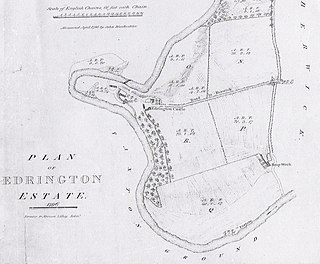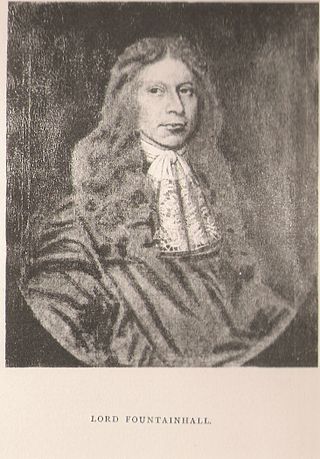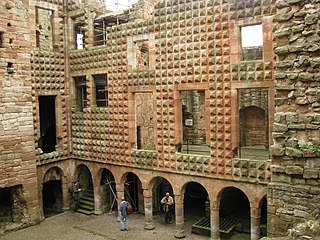Related Research Articles

Clan Agnew is a Scottish clan from Galloway in the Scottish Lowlands.
Sir Robert Lauder of the Bass was a Scottish knight, armiger, and Governor of the Castle at Berwick-upon-Tweed. He was also a member of the old Scottish Parliament. The Lauders held the feudal barony of The Bass, East Lothian, Edrington Castle and lands in the parish of Mordington, Berwickshire, Tyninghame in Haddingtonshire, and numerous other estates and properties elsewhere in Scotland.

John Hay, 2nd Marquess of Tweeddale PC was a Scottish nobleman.

The House of Burnett is a Lowland and Border Scottish family composed of several branches. The Chief of the Name and Arms of Burnett is James Comyn Amherst Burnett of Leys.
Lamberton is a hilly, former landed estate in Berwickshire, Scotland, its eastern boundary being the North Sea. It is 4 miles (6.4 km) north of Berwick-upon-Tweed, on the Great North Road.

Edrington is a medieval estate occupying the lower part of Mordington parish in Berwickshire, Scotland, five miles (8.0 km) west of Berwick-upon-Tweed. From probably the 14th century, if not earlier, a castle occupied the steep hill above the mill of the same name on the Whiteadder Water. The castle ruin is still marked on today's Ordnance Survey maps, and still appears in locality references in The Berwickshire News. The principal farm of the estate is Edrington Mains.

Sir John Lauder, 1st Baronet, of Newington and Fountainhall was a notable Scottish baillie and Treasurer of the City of Edinburgh Council, who was raised to a Nova Scotia baronetcy in 1688.

James Stuart, 4th Earl of Moray was a Scottish landowner.

Sir John Lauder of Fountainhall, 2nd Baronet, Lord Fountainhall was one of Scotland's leading jurists who remains an oft-consulted authority. He was knighted in 1680 and matriculated his Arms with the Lyon Court on 15 June 1699.

Adam Cockburn, Laird of Ormiston, Lord Ormiston, was a Scottish administrator, politician and judge. He served as Commissioner for Haddington Constabulary in the parliaments of 1681-2 and 1689, and in the conventions of 1678 and 1689. He was appointed Lord Justice Clerk on 28 November 1692.
Sir Alexander Home of that Ilk, 1st Lord Home was in 1448 Sheriff Deputy for Berwickshire, and was made a Lord of Parliament on 2 August 1473. He is an ancestor of the Earls of Home.

Sir Andrew Ramsay, Lord Abbotshall, Privy Counsellor, was the first Lord Provost of Edinburgh and a judge of the Court of Session.
There have been five baronetcies created for people with the surname Forbes, four in the Baronetage of Nova Scotia and one in the Baronetage of the United Kingdom. The first holder of the Burn baronetcy of Jessfield, created in the Baronetage of the United Kingdom in 1923, assumed the surname of Forbes-Leith of Fyvie in 1925.

Coldingham Priory was a house of Benedictine monks. It lies on the south-east coast of Scotland, in the village of Coldingham, Berwickshire. Coldingham Priory was founded in the reign of David I of Scotland, although his older brother and predecessor King Edgar of Scotland had granted the land of Coldingham to the Church of Durham in 1098, and a church was constructed by him and presented in 1100. The first prior of Coldingham is on record by the year 1147, although it is likely that the foundation was much earlier. The earlier monastery at Coldingham was founded by St Æbbe sometime c. AD 640. Although the monastery was largely destroyed by Oliver Cromwell in 1650, some remains of the priory exist, the choir of which forms the present parish church of Coldingham and is serviced by the Church of Scotland.
Sir John Home of Renton, Lord Renton was appointed Lord Justice Clerk by King Charles II. He was also a Senator of the College of Justice with the title Lord Renton.
Sir Alexander Lauder of Blyth, Knt. was Provost of Edinburgh almost continually from 1500 to 1513. He was Commissioner to the Scottish Parliament, 1504–06, and an Auditor of the Exchequer in Scotland. He appears to have been on terms of intimacy with the King, James IV, with whom he played cards and to whom he occasionally lent money. "He led the men of Edinburgh to join the King's host" at the battle of Flodden, and fell there.
There have been five baronetcies created for persons with the surname Home, four in the Baronetage of Nova Scotia and one in the Baronetage of the United Kingdom. Only one creation is extant as of 2008.

Francis Stewart, 5th Earl of Bothwell, was Commendator of Kelso Abbey and Coldingham Priory, a Privy Counsellor and Lord High Admiral of Scotland. He was a notorious conspirator who led several uprisings against his first cousin, King James VI, all of which ultimately failed, and he died in poverty in Italy after being banished from Scotland. Francis's maternal uncle, the 4th Earl of Bothwell, was the chief suspect in the murder of James VI's father, Lord Darnley.
Sir Archibald Hope, Lord Rankeillor was a Scottish advocate and judge, the second son of John Hope, Lord Craighall, the grandfather of the botanist John Hope and the great-grandfather of the chemist Thomas Charles Hope, FRSE.
Anne Kerr, Countess of Lothian was a Scottish aristocrat and landowner.
References
- Calendar of the Laing Charters, AD854 – 1837, edited by the Rev. John Anderson, Edinburgh, 1899, number 2722.
- Scott 1118 – 1923, by Keith S.M. Scott, F.S.A.,(Scot), London, 1923, p. 254.
- Index to Genealogies, Birthbriefs and Funeral Escutcheons, recorded in the Lyon Office, by Francis J. Grant, W.S., Rothesay Herald & Lyon Clerk and Keeper of the Records, Edinburgh, 1908, p. 28, for death date and parentage.